Understanding Intermodal Transportation: ISO Containers, Swap Bodies, Piggyback, and Rolling Roads in Europe
VerifiedAdded on 2023/04/25
|15
|3718
|500
AI Summary
The report discusses intermodal transportation, including the purpose and characteristics of ISO containers, swap bodies, piggyback transportation, and rolling roads. It also provides an overview of intermodal transport in Europe, an action plan for developing European intermodal activity, and concludes with references.
Contribute Materials
Your contribution can guide someone’s learning journey. Share your
documents today.
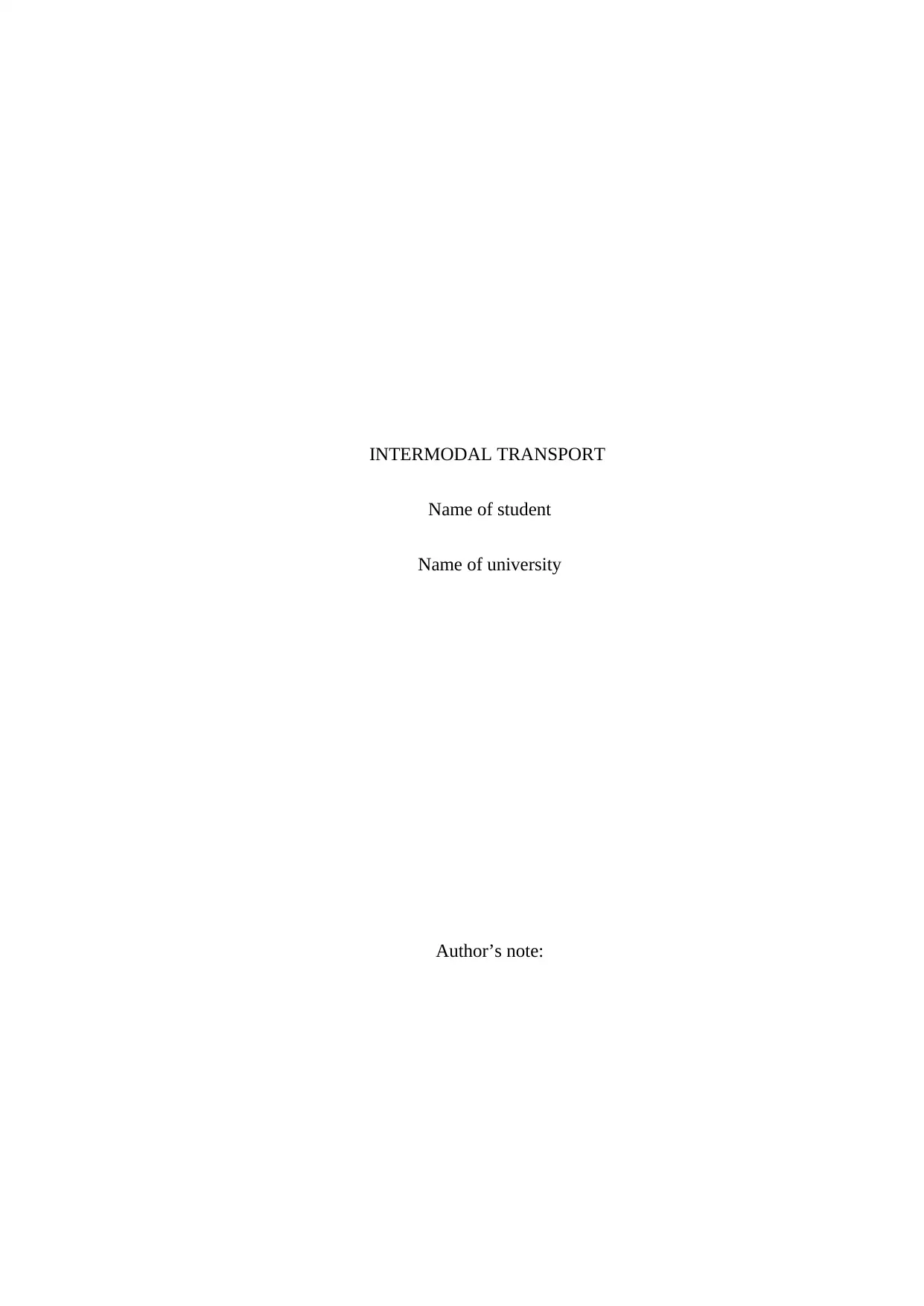
INTERMODAL TRANSPORT
Name of student
Name of university
Author’s note:
Name of student
Name of university
Author’s note:
Secure Best Marks with AI Grader
Need help grading? Try our AI Grader for instant feedback on your assignments.
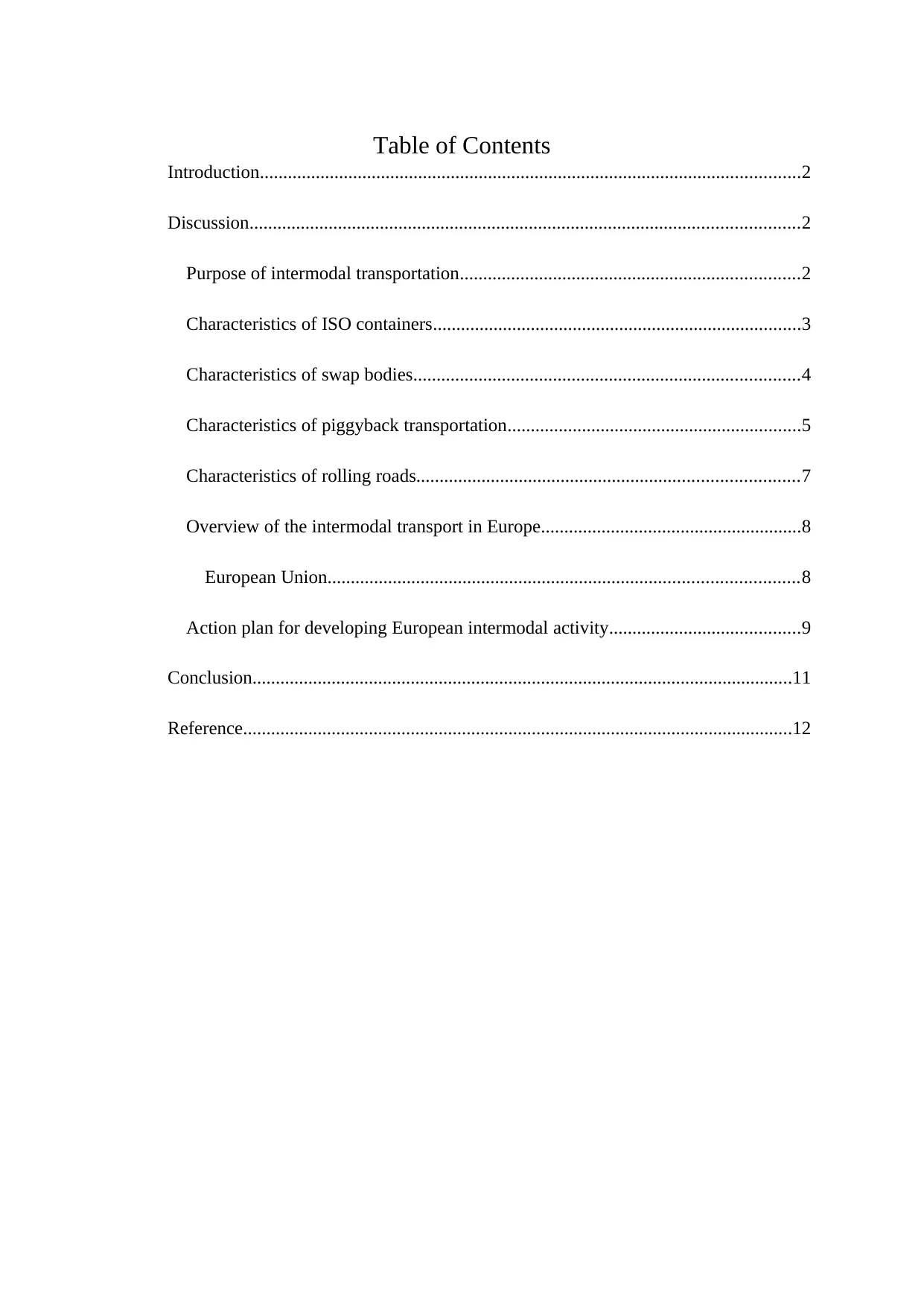
Table of Contents
Introduction....................................................................................................................2
Discussion......................................................................................................................2
Purpose of intermodal transportation.........................................................................2
Characteristics of ISO containers...............................................................................3
Characteristics of swap bodies...................................................................................4
Characteristics of piggyback transportation...............................................................5
Characteristics of rolling roads..................................................................................7
Overview of the intermodal transport in Europe........................................................8
European Union.....................................................................................................8
Action plan for developing European intermodal activity.........................................9
Conclusion....................................................................................................................11
Reference......................................................................................................................12
Introduction....................................................................................................................2
Discussion......................................................................................................................2
Purpose of intermodal transportation.........................................................................2
Characteristics of ISO containers...............................................................................3
Characteristics of swap bodies...................................................................................4
Characteristics of piggyback transportation...............................................................5
Characteristics of rolling roads..................................................................................7
Overview of the intermodal transport in Europe........................................................8
European Union.....................................................................................................8
Action plan for developing European intermodal activity.........................................9
Conclusion....................................................................................................................11
Reference......................................................................................................................12
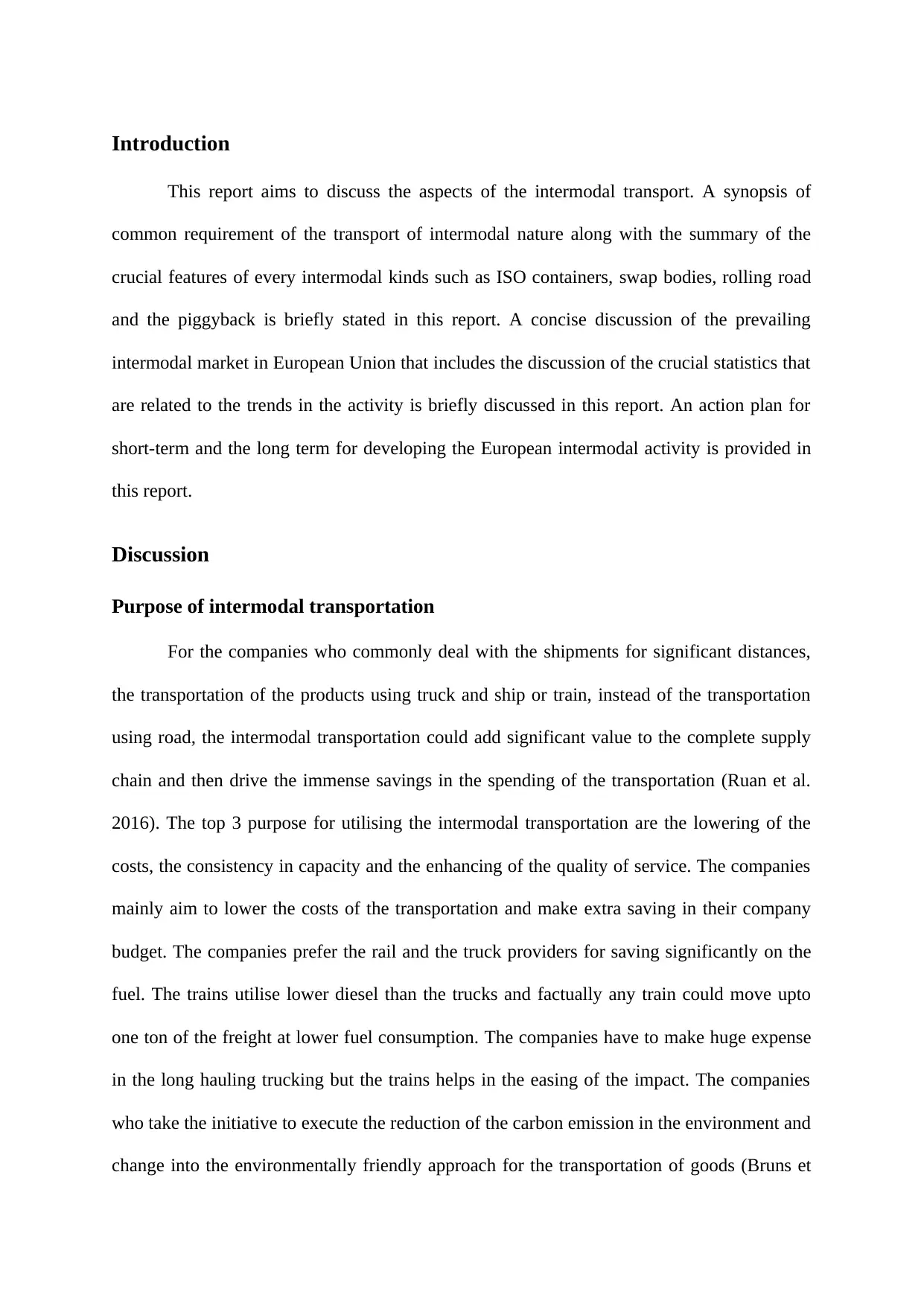
Introduction
This report aims to discuss the aspects of the intermodal transport. A synopsis of
common requirement of the transport of intermodal nature along with the summary of the
crucial features of every intermodal kinds such as ISO containers, swap bodies, rolling road
and the piggyback is briefly stated in this report. A concise discussion of the prevailing
intermodal market in European Union that includes the discussion of the crucial statistics that
are related to the trends in the activity is briefly discussed in this report. An action plan for
short-term and the long term for developing the European intermodal activity is provided in
this report.
Discussion
Purpose of intermodal transportation
For the companies who commonly deal with the shipments for significant distances,
the transportation of the products using truck and ship or train, instead of the transportation
using road, the intermodal transportation could add significant value to the complete supply
chain and then drive the immense savings in the spending of the transportation (Ruan et al.
2016). The top 3 purpose for utilising the intermodal transportation are the lowering of the
costs, the consistency in capacity and the enhancing of the quality of service. The companies
mainly aim to lower the costs of the transportation and make extra saving in their company
budget. The companies prefer the rail and the truck providers for saving significantly on the
fuel. The trains utilise lower diesel than the trucks and factually any train could move upto
one ton of the freight at lower fuel consumption. The companies have to make huge expense
in the long hauling trucking but the trains helps in the easing of the impact. The companies
who take the initiative to execute the reduction of the carbon emission in the environment and
change into the environmentally friendly approach for the transportation of goods (Bruns et
This report aims to discuss the aspects of the intermodal transport. A synopsis of
common requirement of the transport of intermodal nature along with the summary of the
crucial features of every intermodal kinds such as ISO containers, swap bodies, rolling road
and the piggyback is briefly stated in this report. A concise discussion of the prevailing
intermodal market in European Union that includes the discussion of the crucial statistics that
are related to the trends in the activity is briefly discussed in this report. An action plan for
short-term and the long term for developing the European intermodal activity is provided in
this report.
Discussion
Purpose of intermodal transportation
For the companies who commonly deal with the shipments for significant distances,
the transportation of the products using truck and ship or train, instead of the transportation
using road, the intermodal transportation could add significant value to the complete supply
chain and then drive the immense savings in the spending of the transportation (Ruan et al.
2016). The top 3 purpose for utilising the intermodal transportation are the lowering of the
costs, the consistency in capacity and the enhancing of the quality of service. The companies
mainly aim to lower the costs of the transportation and make extra saving in their company
budget. The companies prefer the rail and the truck providers for saving significantly on the
fuel. The trains utilise lower diesel than the trucks and factually any train could move upto
one ton of the freight at lower fuel consumption. The companies have to make huge expense
in the long hauling trucking but the trains helps in the easing of the impact. The companies
who take the initiative to execute the reduction of the carbon emission in the environment and
change into the environmentally friendly approach for the transportation of goods (Bruns et
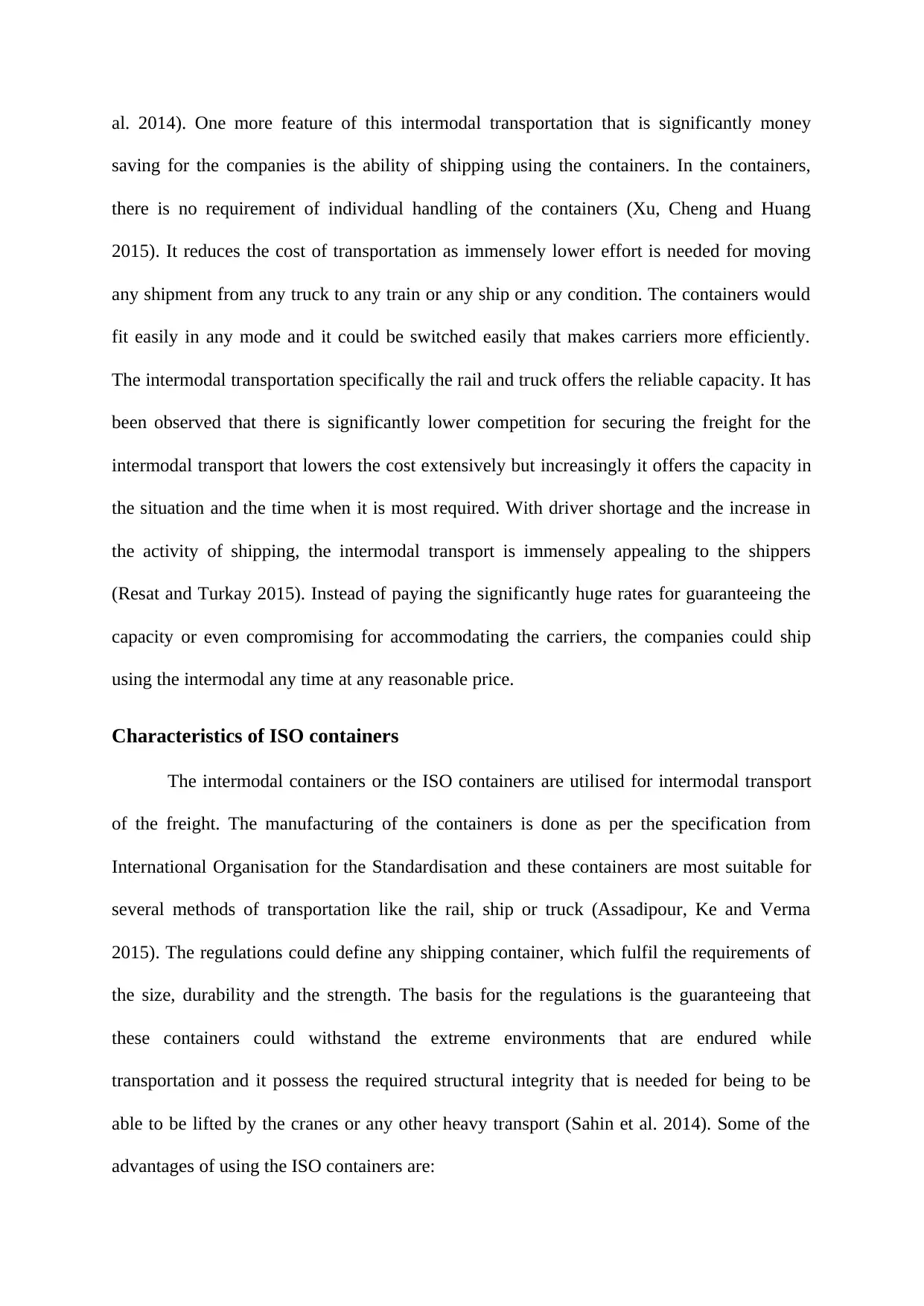
al. 2014). One more feature of this intermodal transportation that is significantly money
saving for the companies is the ability of shipping using the containers. In the containers,
there is no requirement of individual handling of the containers (Xu, Cheng and Huang
2015). It reduces the cost of transportation as immensely lower effort is needed for moving
any shipment from any truck to any train or any ship or any condition. The containers would
fit easily in any mode and it could be switched easily that makes carriers more efficiently.
The intermodal transportation specifically the rail and truck offers the reliable capacity. It has
been observed that there is significantly lower competition for securing the freight for the
intermodal transport that lowers the cost extensively but increasingly it offers the capacity in
the situation and the time when it is most required. With driver shortage and the increase in
the activity of shipping, the intermodal transport is immensely appealing to the shippers
(Resat and Turkay 2015). Instead of paying the significantly huge rates for guaranteeing the
capacity or even compromising for accommodating the carriers, the companies could ship
using the intermodal any time at any reasonable price.
Characteristics of ISO containers
The intermodal containers or the ISO containers are utilised for intermodal transport
of the freight. The manufacturing of the containers is done as per the specification from
International Organisation for the Standardisation and these containers are most suitable for
several methods of transportation like the rail, ship or truck (Assadipour, Ke and Verma
2015). The regulations could define any shipping container, which fulfil the requirements of
the size, durability and the strength. The basis for the regulations is the guaranteeing that
these containers could withstand the extreme environments that are endured while
transportation and it possess the required structural integrity that is needed for being to be
able to be lifted by the cranes or any other heavy transport (Sahin et al. 2014). Some of the
advantages of using the ISO containers are:
saving for the companies is the ability of shipping using the containers. In the containers,
there is no requirement of individual handling of the containers (Xu, Cheng and Huang
2015). It reduces the cost of transportation as immensely lower effort is needed for moving
any shipment from any truck to any train or any ship or any condition. The containers would
fit easily in any mode and it could be switched easily that makes carriers more efficiently.
The intermodal transportation specifically the rail and truck offers the reliable capacity. It has
been observed that there is significantly lower competition for securing the freight for the
intermodal transport that lowers the cost extensively but increasingly it offers the capacity in
the situation and the time when it is most required. With driver shortage and the increase in
the activity of shipping, the intermodal transport is immensely appealing to the shippers
(Resat and Turkay 2015). Instead of paying the significantly huge rates for guaranteeing the
capacity or even compromising for accommodating the carriers, the companies could ship
using the intermodal any time at any reasonable price.
Characteristics of ISO containers
The intermodal containers or the ISO containers are utilised for intermodal transport
of the freight. The manufacturing of the containers is done as per the specification from
International Organisation for the Standardisation and these containers are most suitable for
several methods of transportation like the rail, ship or truck (Assadipour, Ke and Verma
2015). The regulations could define any shipping container, which fulfil the requirements of
the size, durability and the strength. The basis for the regulations is the guaranteeing that
these containers could withstand the extreme environments that are endured while
transportation and it possess the required structural integrity that is needed for being to be
able to be lifted by the cranes or any other heavy transport (Sahin et al. 2014). Some of the
advantages of using the ISO containers are:
Secure Best Marks with AI Grader
Need help grading? Try our AI Grader for instant feedback on your assignments.
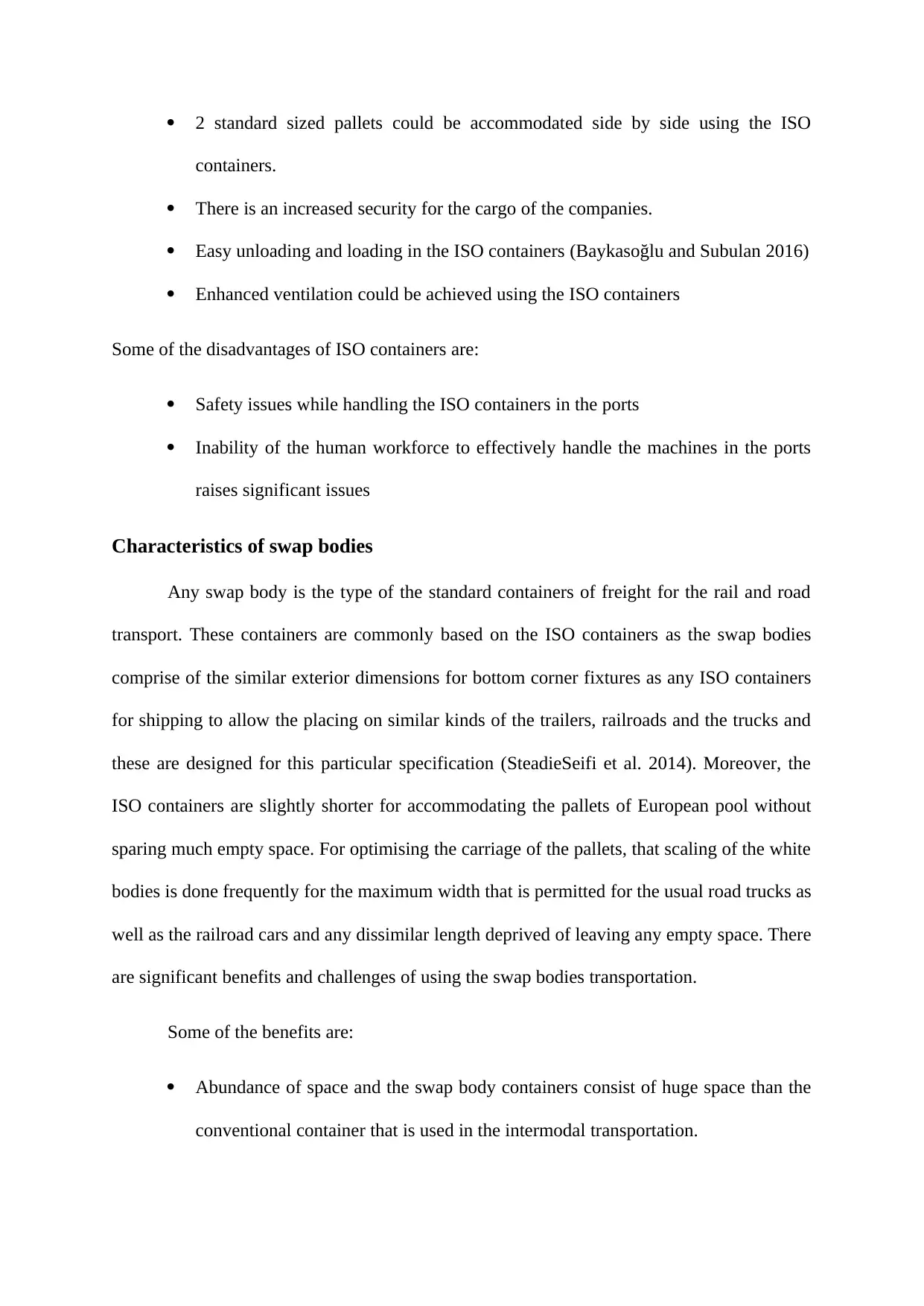
2 standard sized pallets could be accommodated side by side using the ISO
containers.
There is an increased security for the cargo of the companies.
Easy unloading and loading in the ISO containers (Baykasoğlu and Subulan 2016)
Enhanced ventilation could be achieved using the ISO containers
Some of the disadvantages of ISO containers are:
Safety issues while handling the ISO containers in the ports
Inability of the human workforce to effectively handle the machines in the ports
raises significant issues
Characteristics of swap bodies
Any swap body is the type of the standard containers of freight for the rail and road
transport. These containers are commonly based on the ISO containers as the swap bodies
comprise of the similar exterior dimensions for bottom corner fixtures as any ISO containers
for shipping to allow the placing on similar kinds of the trailers, railroads and the trucks and
these are designed for this particular specification (SteadieSeifi et al. 2014). Moreover, the
ISO containers are slightly shorter for accommodating the pallets of European pool without
sparing much empty space. For optimising the carriage of the pallets, that scaling of the white
bodies is done frequently for the maximum width that is permitted for the usual road trucks as
well as the railroad cars and any dissimilar length deprived of leaving any empty space. There
are significant benefits and challenges of using the swap bodies transportation.
Some of the benefits are:
Abundance of space and the swap body containers consist of huge space than the
conventional container that is used in the intermodal transportation.
containers.
There is an increased security for the cargo of the companies.
Easy unloading and loading in the ISO containers (Baykasoğlu and Subulan 2016)
Enhanced ventilation could be achieved using the ISO containers
Some of the disadvantages of ISO containers are:
Safety issues while handling the ISO containers in the ports
Inability of the human workforce to effectively handle the machines in the ports
raises significant issues
Characteristics of swap bodies
Any swap body is the type of the standard containers of freight for the rail and road
transport. These containers are commonly based on the ISO containers as the swap bodies
comprise of the similar exterior dimensions for bottom corner fixtures as any ISO containers
for shipping to allow the placing on similar kinds of the trailers, railroads and the trucks and
these are designed for this particular specification (SteadieSeifi et al. 2014). Moreover, the
ISO containers are slightly shorter for accommodating the pallets of European pool without
sparing much empty space. For optimising the carriage of the pallets, that scaling of the white
bodies is done frequently for the maximum width that is permitted for the usual road trucks as
well as the railroad cars and any dissimilar length deprived of leaving any empty space. There
are significant benefits and challenges of using the swap bodies transportation.
Some of the benefits are:
Abundance of space and the swap body containers consist of huge space than the
conventional container that is used in the intermodal transportation.
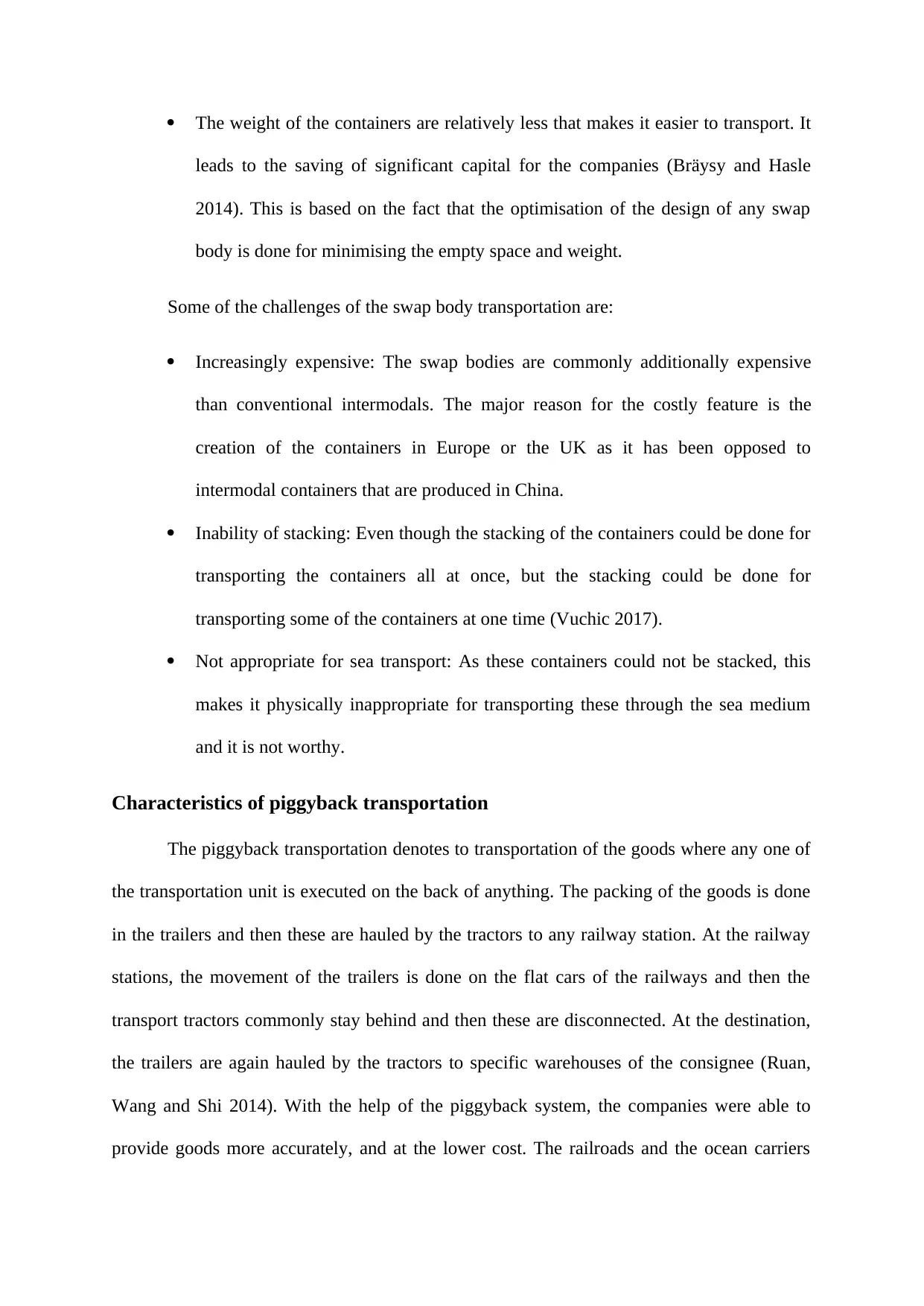
The weight of the containers are relatively less that makes it easier to transport. It
leads to the saving of significant capital for the companies (Bräysy and Hasle
2014). This is based on the fact that the optimisation of the design of any swap
body is done for minimising the empty space and weight.
Some of the challenges of the swap body transportation are:
Increasingly expensive: The swap bodies are commonly additionally expensive
than conventional intermodals. The major reason for the costly feature is the
creation of the containers in Europe or the UK as it has been opposed to
intermodal containers that are produced in China.
Inability of stacking: Even though the stacking of the containers could be done for
transporting the containers all at once, but the stacking could be done for
transporting some of the containers at one time (Vuchic 2017).
Not appropriate for sea transport: As these containers could not be stacked, this
makes it physically inappropriate for transporting these through the sea medium
and it is not worthy.
Characteristics of piggyback transportation
The piggyback transportation denotes to transportation of the goods where any one of
the transportation unit is executed on the back of anything. The packing of the goods is done
in the trailers and then these are hauled by the tractors to any railway station. At the railway
stations, the movement of the trailers is done on the flat cars of the railways and then the
transport tractors commonly stay behind and then these are disconnected. At the destination,
the trailers are again hauled by the tractors to specific warehouses of the consignee (Ruan,
Wang and Shi 2014). With the help of the piggyback system, the companies were able to
provide goods more accurately, and at the lower cost. The railroads and the ocean carriers
leads to the saving of significant capital for the companies (Bräysy and Hasle
2014). This is based on the fact that the optimisation of the design of any swap
body is done for minimising the empty space and weight.
Some of the challenges of the swap body transportation are:
Increasingly expensive: The swap bodies are commonly additionally expensive
than conventional intermodals. The major reason for the costly feature is the
creation of the containers in Europe or the UK as it has been opposed to
intermodal containers that are produced in China.
Inability of stacking: Even though the stacking of the containers could be done for
transporting the containers all at once, but the stacking could be done for
transporting some of the containers at one time (Vuchic 2017).
Not appropriate for sea transport: As these containers could not be stacked, this
makes it physically inappropriate for transporting these through the sea medium
and it is not worthy.
Characteristics of piggyback transportation
The piggyback transportation denotes to transportation of the goods where any one of
the transportation unit is executed on the back of anything. The packing of the goods is done
in the trailers and then these are hauled by the tractors to any railway station. At the railway
stations, the movement of the trailers is done on the flat cars of the railways and then the
transport tractors commonly stay behind and then these are disconnected. At the destination,
the trailers are again hauled by the tractors to specific warehouses of the consignee (Ruan,
Wang and Shi 2014). With the help of the piggyback system, the companies were able to
provide goods more accurately, and at the lower cost. The railroads and the ocean carriers
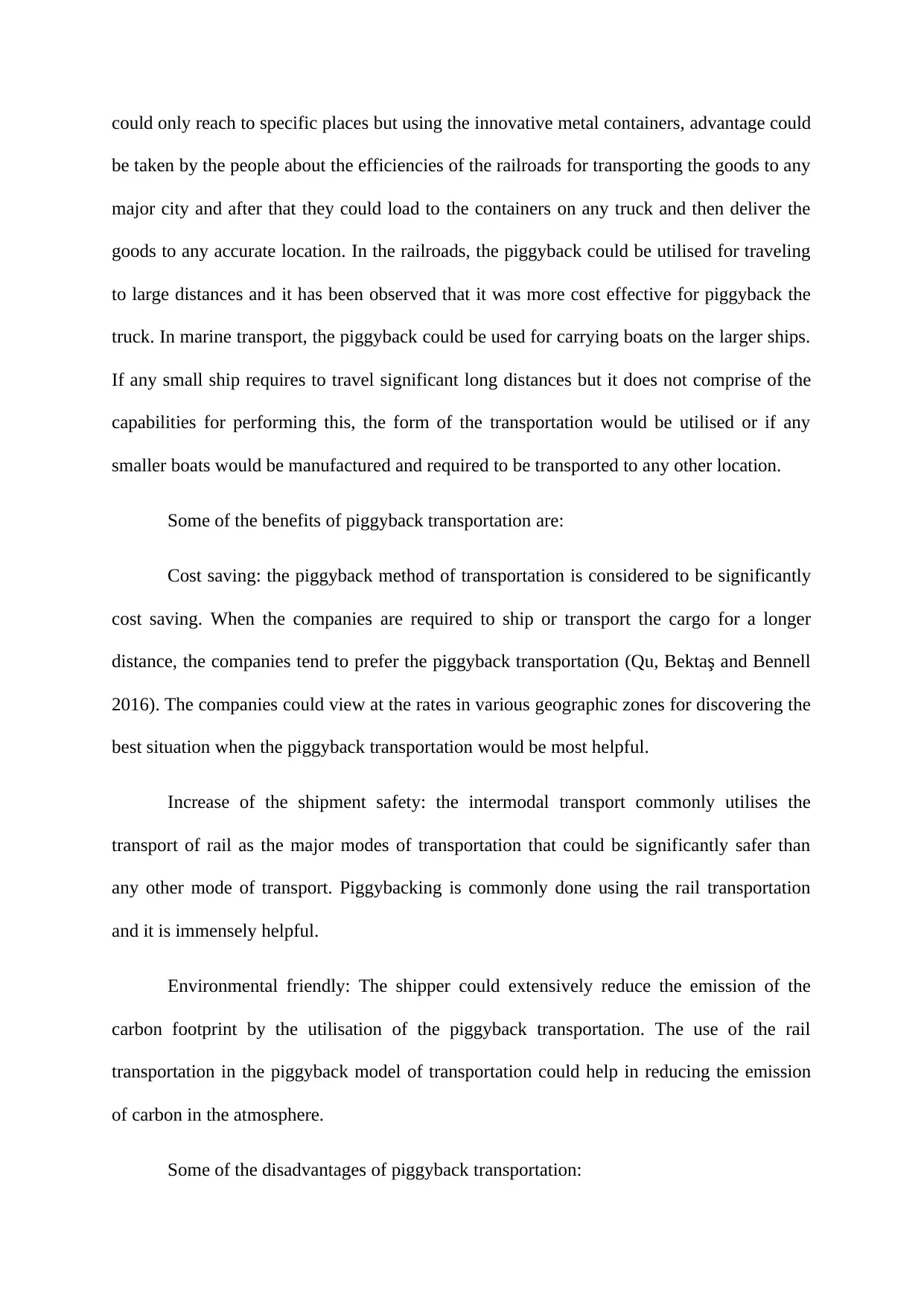
could only reach to specific places but using the innovative metal containers, advantage could
be taken by the people about the efficiencies of the railroads for transporting the goods to any
major city and after that they could load to the containers on any truck and then deliver the
goods to any accurate location. In the railroads, the piggyback could be utilised for traveling
to large distances and it has been observed that it was more cost effective for piggyback the
truck. In marine transport, the piggyback could be used for carrying boats on the larger ships.
If any small ship requires to travel significant long distances but it does not comprise of the
capabilities for performing this, the form of the transportation would be utilised or if any
smaller boats would be manufactured and required to be transported to any other location.
Some of the benefits of piggyback transportation are:
Cost saving: the piggyback method of transportation is considered to be significantly
cost saving. When the companies are required to ship or transport the cargo for a longer
distance, the companies tend to prefer the piggyback transportation (Qu, Bektaş and Bennell
2016). The companies could view at the rates in various geographic zones for discovering the
best situation when the piggyback transportation would be most helpful.
Increase of the shipment safety: the intermodal transport commonly utilises the
transport of rail as the major modes of transportation that could be significantly safer than
any other mode of transport. Piggybacking is commonly done using the rail transportation
and it is immensely helpful.
Environmental friendly: The shipper could extensively reduce the emission of the
carbon footprint by the utilisation of the piggyback transportation. The use of the rail
transportation in the piggyback model of transportation could help in reducing the emission
of carbon in the atmosphere.
Some of the disadvantages of piggyback transportation:
be taken by the people about the efficiencies of the railroads for transporting the goods to any
major city and after that they could load to the containers on any truck and then deliver the
goods to any accurate location. In the railroads, the piggyback could be utilised for traveling
to large distances and it has been observed that it was more cost effective for piggyback the
truck. In marine transport, the piggyback could be used for carrying boats on the larger ships.
If any small ship requires to travel significant long distances but it does not comprise of the
capabilities for performing this, the form of the transportation would be utilised or if any
smaller boats would be manufactured and required to be transported to any other location.
Some of the benefits of piggyback transportation are:
Cost saving: the piggyback method of transportation is considered to be significantly
cost saving. When the companies are required to ship or transport the cargo for a longer
distance, the companies tend to prefer the piggyback transportation (Qu, Bektaş and Bennell
2016). The companies could view at the rates in various geographic zones for discovering the
best situation when the piggyback transportation would be most helpful.
Increase of the shipment safety: the intermodal transport commonly utilises the
transport of rail as the major modes of transportation that could be significantly safer than
any other mode of transport. Piggybacking is commonly done using the rail transportation
and it is immensely helpful.
Environmental friendly: The shipper could extensively reduce the emission of the
carbon footprint by the utilisation of the piggyback transportation. The use of the rail
transportation in the piggyback model of transportation could help in reducing the emission
of carbon in the atmosphere.
Some of the disadvantages of piggyback transportation:
Paraphrase This Document
Need a fresh take? Get an instant paraphrase of this document with our AI Paraphraser
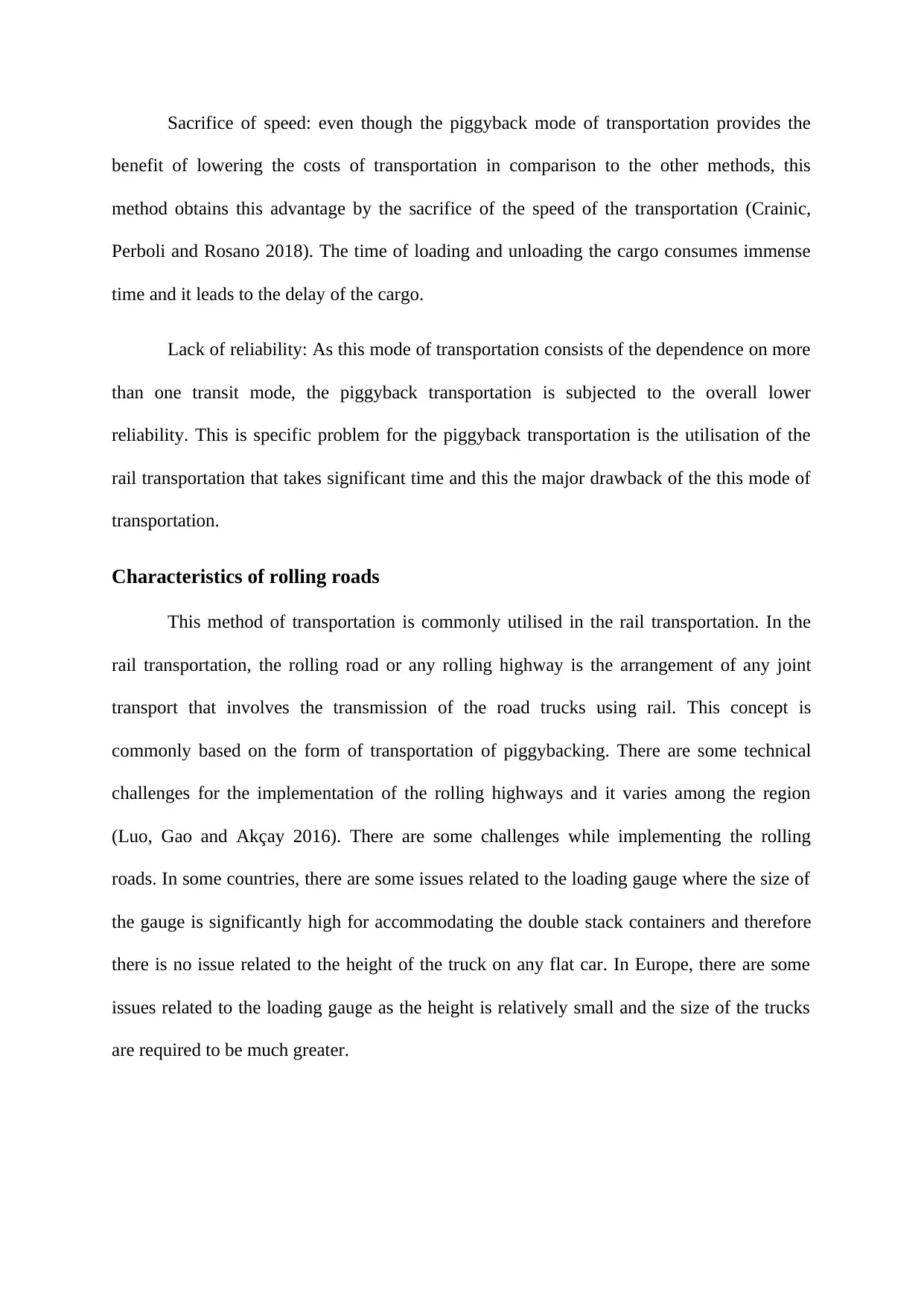
Sacrifice of speed: even though the piggyback mode of transportation provides the
benefit of lowering the costs of transportation in comparison to the other methods, this
method obtains this advantage by the sacrifice of the speed of the transportation (Crainic,
Perboli and Rosano 2018). The time of loading and unloading the cargo consumes immense
time and it leads to the delay of the cargo.
Lack of reliability: As this mode of transportation consists of the dependence on more
than one transit mode, the piggyback transportation is subjected to the overall lower
reliability. This is specific problem for the piggyback transportation is the utilisation of the
rail transportation that takes significant time and this the major drawback of the this mode of
transportation.
Characteristics of rolling roads
This method of transportation is commonly utilised in the rail transportation. In the
rail transportation, the rolling road or any rolling highway is the arrangement of any joint
transport that involves the transmission of the road trucks using rail. This concept is
commonly based on the form of transportation of piggybacking. There are some technical
challenges for the implementation of the rolling highways and it varies among the region
(Luo, Gao and Akçay 2016). There are some challenges while implementing the rolling
roads. In some countries, there are some issues related to the loading gauge where the size of
the gauge is significantly high for accommodating the double stack containers and therefore
there is no issue related to the height of the truck on any flat car. In Europe, there are some
issues related to the loading gauge as the height is relatively small and the size of the trucks
are required to be much greater.
benefit of lowering the costs of transportation in comparison to the other methods, this
method obtains this advantage by the sacrifice of the speed of the transportation (Crainic,
Perboli and Rosano 2018). The time of loading and unloading the cargo consumes immense
time and it leads to the delay of the cargo.
Lack of reliability: As this mode of transportation consists of the dependence on more
than one transit mode, the piggyback transportation is subjected to the overall lower
reliability. This is specific problem for the piggyback transportation is the utilisation of the
rail transportation that takes significant time and this the major drawback of the this mode of
transportation.
Characteristics of rolling roads
This method of transportation is commonly utilised in the rail transportation. In the
rail transportation, the rolling road or any rolling highway is the arrangement of any joint
transport that involves the transmission of the road trucks using rail. This concept is
commonly based on the form of transportation of piggybacking. There are some technical
challenges for the implementation of the rolling highways and it varies among the region
(Luo, Gao and Akçay 2016). There are some challenges while implementing the rolling
roads. In some countries, there are some issues related to the loading gauge where the size of
the gauge is significantly high for accommodating the double stack containers and therefore
there is no issue related to the height of the truck on any flat car. In Europe, there are some
issues related to the loading gauge as the height is relatively small and the size of the trucks
are required to be much greater.
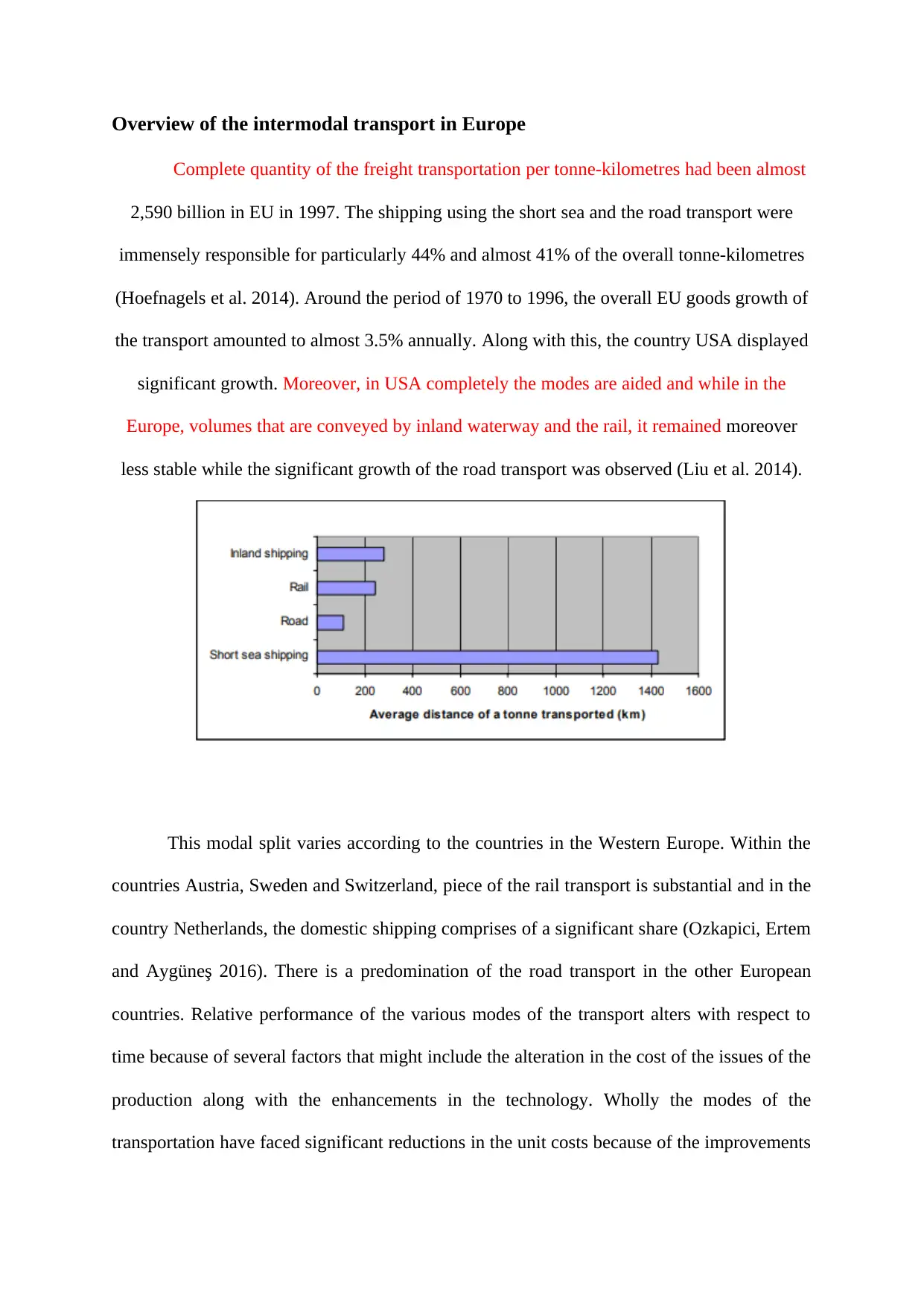
Overview of the intermodal transport in Europe
Complete quantity of the freight transportation per tonne-kilometres had been almost
2,590 billion in EU in 1997. The shipping using the short sea and the road transport were
immensely responsible for particularly 44% and almost 41% of the overall tonne-kilometres
(Hoefnagels et al. 2014). Around the period of 1970 to 1996, the overall EU goods growth of
the transport amounted to almost 3.5% annually. Along with this, the country USA displayed
significant growth. Moreover, in USA completely the modes are aided and while in the
Europe, volumes that are conveyed by inland waterway and the rail, it remained moreover
less stable while the significant growth of the road transport was observed (Liu et al. 2014).
This modal split varies according to the countries in the Western Europe. Within the
countries Austria, Sweden and Switzerland, piece of the rail transport is substantial and in the
country Netherlands, the domestic shipping comprises of a significant share (Ozkapici, Ertem
and Aygüneş 2016). There is a predomination of the road transport in the other European
countries. Relative performance of the various modes of the transport alters with respect to
time because of several factors that might include the alteration in the cost of the issues of the
production along with the enhancements in the technology. Wholly the modes of the
transportation have faced significant reductions in the unit costs because of the improvements
Complete quantity of the freight transportation per tonne-kilometres had been almost
2,590 billion in EU in 1997. The shipping using the short sea and the road transport were
immensely responsible for particularly 44% and almost 41% of the overall tonne-kilometres
(Hoefnagels et al. 2014). Around the period of 1970 to 1996, the overall EU goods growth of
the transport amounted to almost 3.5% annually. Along with this, the country USA displayed
significant growth. Moreover, in USA completely the modes are aided and while in the
Europe, volumes that are conveyed by inland waterway and the rail, it remained moreover
less stable while the significant growth of the road transport was observed (Liu et al. 2014).
This modal split varies according to the countries in the Western Europe. Within the
countries Austria, Sweden and Switzerland, piece of the rail transport is substantial and in the
country Netherlands, the domestic shipping comprises of a significant share (Ozkapici, Ertem
and Aygüneş 2016). There is a predomination of the road transport in the other European
countries. Relative performance of the various modes of the transport alters with respect to
time because of several factors that might include the alteration in the cost of the issues of the
production along with the enhancements in the technology. Wholly the modes of the
transportation have faced significant reductions in the unit costs because of the improvements
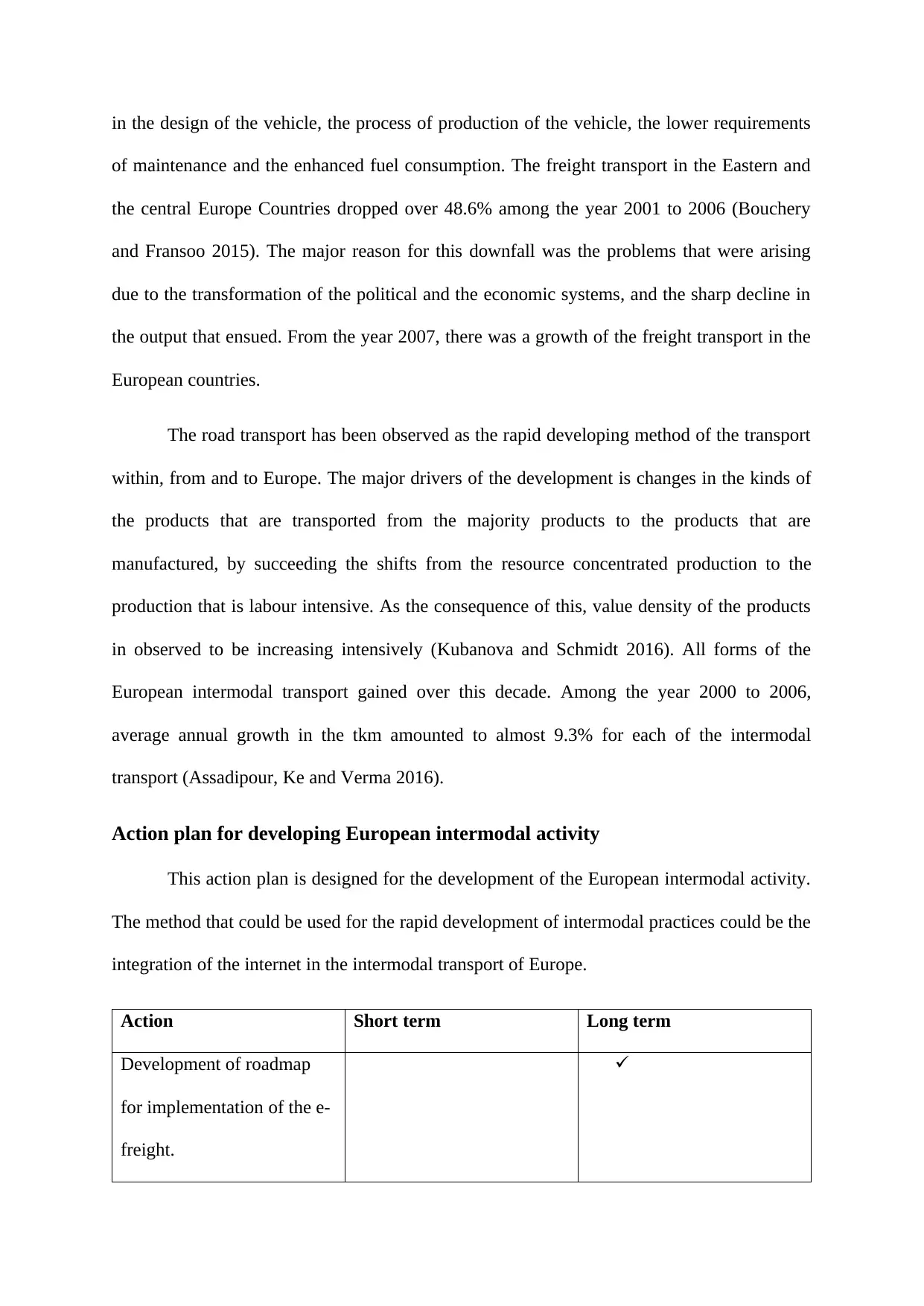
in the design of the vehicle, the process of production of the vehicle, the lower requirements
of maintenance and the enhanced fuel consumption. The freight transport in the Eastern and
the central Europe Countries dropped over 48.6% among the year 2001 to 2006 (Bouchery
and Fransoo 2015). The major reason for this downfall was the problems that were arising
due to the transformation of the political and the economic systems, and the sharp decline in
the output that ensued. From the year 2007, there was a growth of the freight transport in the
European countries.
The road transport has been observed as the rapid developing method of the transport
within, from and to Europe. The major drivers of the development is changes in the kinds of
the products that are transported from the majority products to the products that are
manufactured, by succeeding the shifts from the resource concentrated production to the
production that is labour intensive. As the consequence of this, value density of the products
in observed to be increasing intensively (Kubanova and Schmidt 2016). All forms of the
European intermodal transport gained over this decade. Among the year 2000 to 2006,
average annual growth in the tkm amounted to almost 9.3% for each of the intermodal
transport (Assadipour, Ke and Verma 2016).
Action plan for developing European intermodal activity
This action plan is designed for the development of the European intermodal activity.
The method that could be used for the rapid development of intermodal practices could be the
integration of the internet in the intermodal transport of Europe.
Action Short term Long term
Development of roadmap
for implementation of the e-
freight.
of maintenance and the enhanced fuel consumption. The freight transport in the Eastern and
the central Europe Countries dropped over 48.6% among the year 2001 to 2006 (Bouchery
and Fransoo 2015). The major reason for this downfall was the problems that were arising
due to the transformation of the political and the economic systems, and the sharp decline in
the output that ensued. From the year 2007, there was a growth of the freight transport in the
European countries.
The road transport has been observed as the rapid developing method of the transport
within, from and to Europe. The major drivers of the development is changes in the kinds of
the products that are transported from the majority products to the products that are
manufactured, by succeeding the shifts from the resource concentrated production to the
production that is labour intensive. As the consequence of this, value density of the products
in observed to be increasing intensively (Kubanova and Schmidt 2016). All forms of the
European intermodal transport gained over this decade. Among the year 2000 to 2006,
average annual growth in the tkm amounted to almost 9.3% for each of the intermodal
transport (Assadipour, Ke and Verma 2016).
Action plan for developing European intermodal activity
This action plan is designed for the development of the European intermodal activity.
The method that could be used for the rapid development of intermodal practices could be the
integration of the internet in the intermodal transport of Europe.
Action Short term Long term
Development of roadmap
for implementation of the e-
freight.
Secure Best Marks with AI Grader
Need help grading? Try our AI Grader for instant feedback on your assignments.
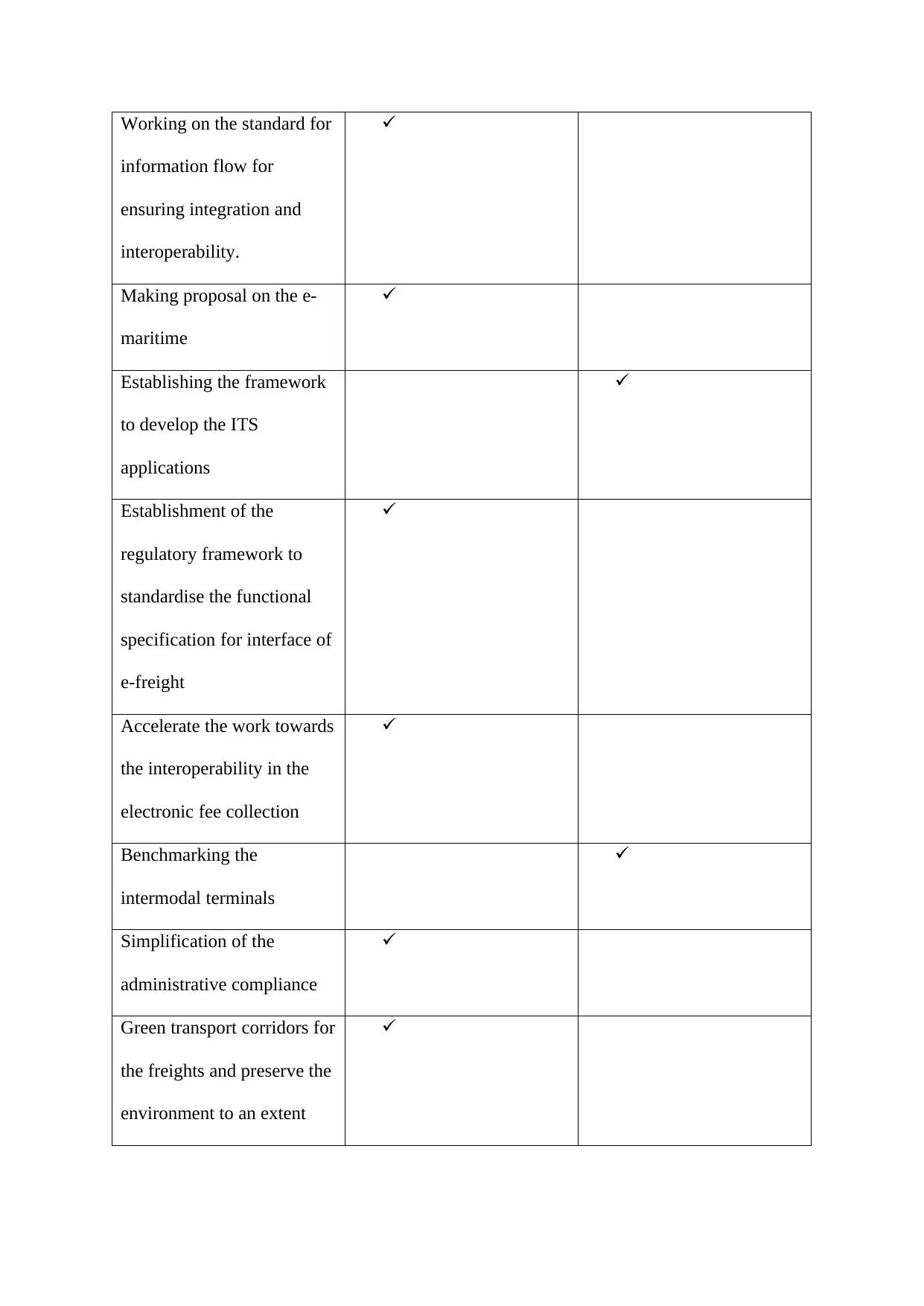
Working on the standard for
information flow for
ensuring integration and
interoperability.
Making proposal on the e-
maritime
Establishing the framework
to develop the ITS
applications
Establishment of the
regulatory framework to
standardise the functional
specification for interface of
e-freight
Accelerate the work towards
the interoperability in the
electronic fee collection
Benchmarking the
intermodal terminals
Simplification of the
administrative compliance
Green transport corridors for
the freights and preserve the
environment to an extent
information flow for
ensuring integration and
interoperability.
Making proposal on the e-
maritime
Establishing the framework
to develop the ITS
applications
Establishment of the
regulatory framework to
standardise the functional
specification for interface of
e-freight
Accelerate the work towards
the interoperability in the
electronic fee collection
Benchmarking the
intermodal terminals
Simplification of the
administrative compliance
Green transport corridors for
the freights and preserve the
environment to an extent

Conclusion
Therefore, it could be concluded from the above discussion that the intermodal
transport types are becoming to be the most popular method of transporting the cargo among
the countries. The companies mainly aim to lower the costs of the transportation and make
extra saving in their company budget. The companies prefer the rail and the truck providers
for saving significantly on the fuel. The trains utilise lower diesel than the trucks and
factually any train could move upto one ton of the freight at lower fuel consumption.The
intermodal containers or the ISO containers are utilised for intermodal transport of the
freight. The manufacturing of the containers is done as per the specification from
International Organisation for the Standardisation and these containers are most suitable for
several methods of transportation like the rail, ship or truck. Any swap body is the type of the
standard containers of freight for the rail and road transport. These containers are commonly
based on the ISO containers as the swap bodies comprise of the similar exterior dimensions
for the bottom corner fittings as any ISO shipping containers. The piggyback transportation
denotes to the transportation of the goods in the place where any one of the transportation
unit is executed on the back of anything. The packing of the goods is done in the trailers and
then these are hauled by the tractors to any railway station.
Therefore, it could be concluded from the above discussion that the intermodal
transport types are becoming to be the most popular method of transporting the cargo among
the countries. The companies mainly aim to lower the costs of the transportation and make
extra saving in their company budget. The companies prefer the rail and the truck providers
for saving significantly on the fuel. The trains utilise lower diesel than the trucks and
factually any train could move upto one ton of the freight at lower fuel consumption.The
intermodal containers or the ISO containers are utilised for intermodal transport of the
freight. The manufacturing of the containers is done as per the specification from
International Organisation for the Standardisation and these containers are most suitable for
several methods of transportation like the rail, ship or truck. Any swap body is the type of the
standard containers of freight for the rail and road transport. These containers are commonly
based on the ISO containers as the swap bodies comprise of the similar exterior dimensions
for the bottom corner fittings as any ISO shipping containers. The piggyback transportation
denotes to the transportation of the goods in the place where any one of the transportation
unit is executed on the back of anything. The packing of the goods is done in the trailers and
then these are hauled by the tractors to any railway station.
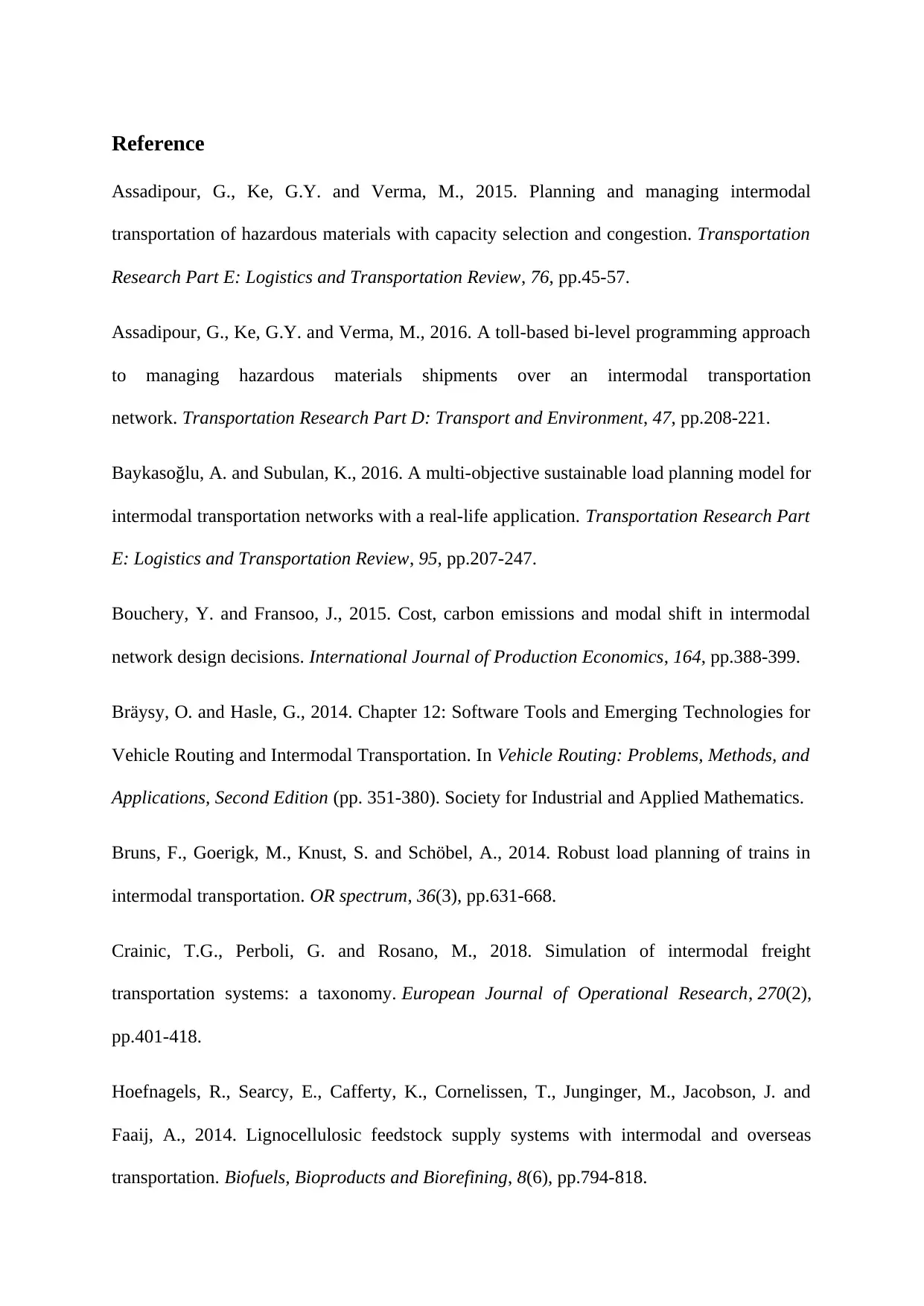
Reference
Assadipour, G., Ke, G.Y. and Verma, M., 2015. Planning and managing intermodal
transportation of hazardous materials with capacity selection and congestion. Transportation
Research Part E: Logistics and Transportation Review, 76, pp.45-57.
Assadipour, G., Ke, G.Y. and Verma, M., 2016. A toll-based bi-level programming approach
to managing hazardous materials shipments over an intermodal transportation
network. Transportation Research Part D: Transport and Environment, 47, pp.208-221.
Baykasoğlu, A. and Subulan, K., 2016. A multi-objective sustainable load planning model for
intermodal transportation networks with a real-life application. Transportation Research Part
E: Logistics and Transportation Review, 95, pp.207-247.
Bouchery, Y. and Fransoo, J., 2015. Cost, carbon emissions and modal shift in intermodal
network design decisions. International Journal of Production Economics, 164, pp.388-399.
Bräysy, O. and Hasle, G., 2014. Chapter 12: Software Tools and Emerging Technologies for
Vehicle Routing and Intermodal Transportation. In Vehicle Routing: Problems, Methods, and
Applications, Second Edition (pp. 351-380). Society for Industrial and Applied Mathematics.
Bruns, F., Goerigk, M., Knust, S. and Schöbel, A., 2014. Robust load planning of trains in
intermodal transportation. OR spectrum, 36(3), pp.631-668.
Crainic, T.G., Perboli, G. and Rosano, M., 2018. Simulation of intermodal freight
transportation systems: a taxonomy. European Journal of Operational Research, 270(2),
pp.401-418.
Hoefnagels, R., Searcy, E., Cafferty, K., Cornelissen, T., Junginger, M., Jacobson, J. and
Faaij, A., 2014. Lignocellulosic feedstock supply systems with intermodal and overseas
transportation. Biofuels, Bioproducts and Biorefining, 8(6), pp.794-818.
Assadipour, G., Ke, G.Y. and Verma, M., 2015. Planning and managing intermodal
transportation of hazardous materials with capacity selection and congestion. Transportation
Research Part E: Logistics and Transportation Review, 76, pp.45-57.
Assadipour, G., Ke, G.Y. and Verma, M., 2016. A toll-based bi-level programming approach
to managing hazardous materials shipments over an intermodal transportation
network. Transportation Research Part D: Transport and Environment, 47, pp.208-221.
Baykasoğlu, A. and Subulan, K., 2016. A multi-objective sustainable load planning model for
intermodal transportation networks with a real-life application. Transportation Research Part
E: Logistics and Transportation Review, 95, pp.207-247.
Bouchery, Y. and Fransoo, J., 2015. Cost, carbon emissions and modal shift in intermodal
network design decisions. International Journal of Production Economics, 164, pp.388-399.
Bräysy, O. and Hasle, G., 2014. Chapter 12: Software Tools and Emerging Technologies for
Vehicle Routing and Intermodal Transportation. In Vehicle Routing: Problems, Methods, and
Applications, Second Edition (pp. 351-380). Society for Industrial and Applied Mathematics.
Bruns, F., Goerigk, M., Knust, S. and Schöbel, A., 2014. Robust load planning of trains in
intermodal transportation. OR spectrum, 36(3), pp.631-668.
Crainic, T.G., Perboli, G. and Rosano, M., 2018. Simulation of intermodal freight
transportation systems: a taxonomy. European Journal of Operational Research, 270(2),
pp.401-418.
Hoefnagels, R., Searcy, E., Cafferty, K., Cornelissen, T., Junginger, M., Jacobson, J. and
Faaij, A., 2014. Lignocellulosic feedstock supply systems with intermodal and overseas
transportation. Biofuels, Bioproducts and Biorefining, 8(6), pp.794-818.
Paraphrase This Document
Need a fresh take? Get an instant paraphrase of this document with our AI Paraphraser
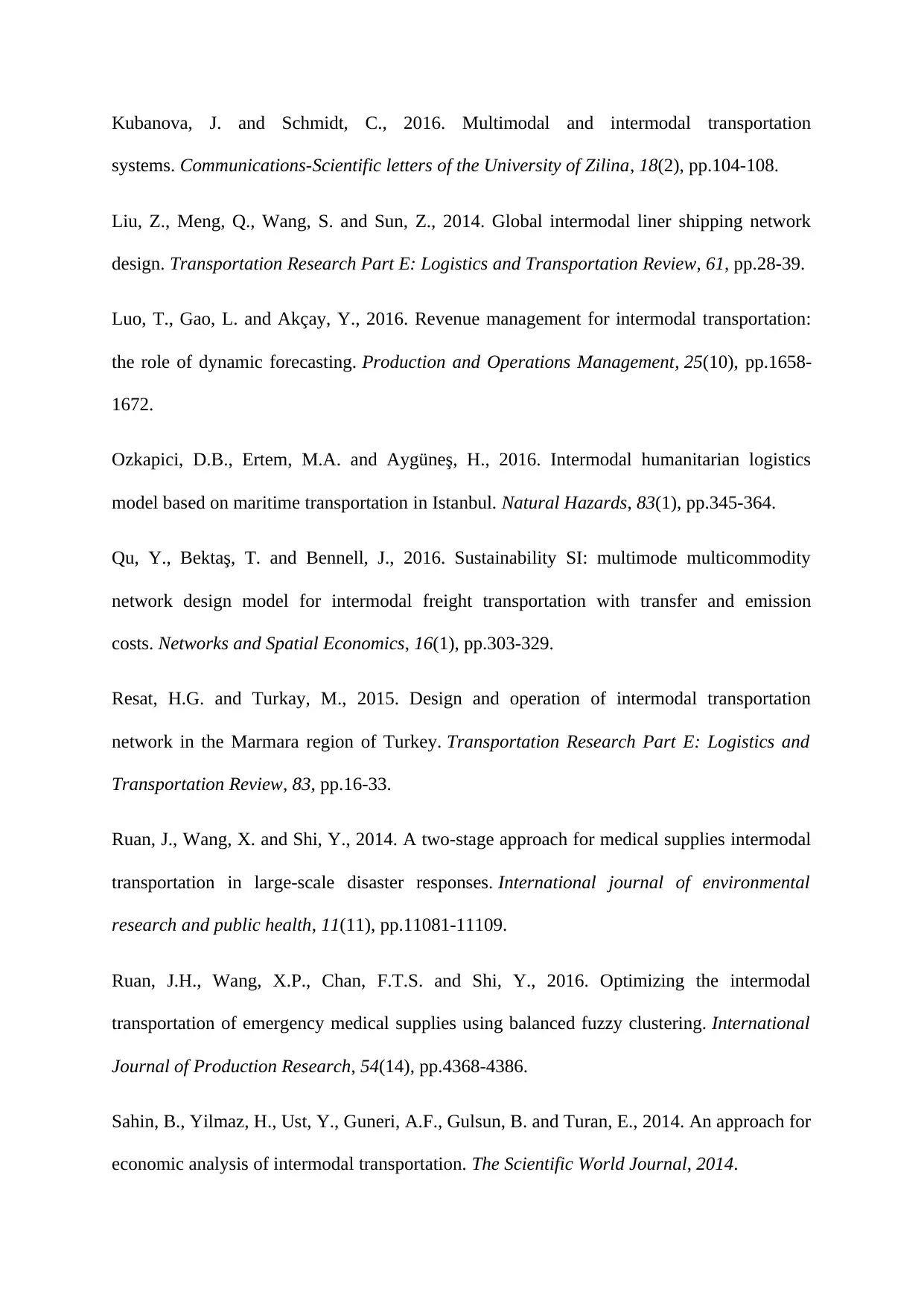
Kubanova, J. and Schmidt, C., 2016. Multimodal and intermodal transportation
systems. Communications-Scientific letters of the University of Zilina, 18(2), pp.104-108.
Liu, Z., Meng, Q., Wang, S. and Sun, Z., 2014. Global intermodal liner shipping network
design. Transportation Research Part E: Logistics and Transportation Review, 61, pp.28-39.
Luo, T., Gao, L. and Akçay, Y., 2016. Revenue management for intermodal transportation:
the role of dynamic forecasting. Production and Operations Management, 25(10), pp.1658-
1672.
Ozkapici, D.B., Ertem, M.A. and Aygüneş, H., 2016. Intermodal humanitarian logistics
model based on maritime transportation in Istanbul. Natural Hazards, 83(1), pp.345-364.
Qu, Y., Bektaş, T. and Bennell, J., 2016. Sustainability SI: multimode multicommodity
network design model for intermodal freight transportation with transfer and emission
costs. Networks and Spatial Economics, 16(1), pp.303-329.
Resat, H.G. and Turkay, M., 2015. Design and operation of intermodal transportation
network in the Marmara region of Turkey. Transportation Research Part E: Logistics and
Transportation Review, 83, pp.16-33.
Ruan, J., Wang, X. and Shi, Y., 2014. A two-stage approach for medical supplies intermodal
transportation in large-scale disaster responses. International journal of environmental
research and public health, 11(11), pp.11081-11109.
Ruan, J.H., Wang, X.P., Chan, F.T.S. and Shi, Y., 2016. Optimizing the intermodal
transportation of emergency medical supplies using balanced fuzzy clustering. International
Journal of Production Research, 54(14), pp.4368-4386.
Sahin, B., Yilmaz, H., Ust, Y., Guneri, A.F., Gulsun, B. and Turan, E., 2014. An approach for
economic analysis of intermodal transportation. The Scientific World Journal, 2014.
systems. Communications-Scientific letters of the University of Zilina, 18(2), pp.104-108.
Liu, Z., Meng, Q., Wang, S. and Sun, Z., 2014. Global intermodal liner shipping network
design. Transportation Research Part E: Logistics and Transportation Review, 61, pp.28-39.
Luo, T., Gao, L. and Akçay, Y., 2016. Revenue management for intermodal transportation:
the role of dynamic forecasting. Production and Operations Management, 25(10), pp.1658-
1672.
Ozkapici, D.B., Ertem, M.A. and Aygüneş, H., 2016. Intermodal humanitarian logistics
model based on maritime transportation in Istanbul. Natural Hazards, 83(1), pp.345-364.
Qu, Y., Bektaş, T. and Bennell, J., 2016. Sustainability SI: multimode multicommodity
network design model for intermodal freight transportation with transfer and emission
costs. Networks and Spatial Economics, 16(1), pp.303-329.
Resat, H.G. and Turkay, M., 2015. Design and operation of intermodal transportation
network in the Marmara region of Turkey. Transportation Research Part E: Logistics and
Transportation Review, 83, pp.16-33.
Ruan, J., Wang, X. and Shi, Y., 2014. A two-stage approach for medical supplies intermodal
transportation in large-scale disaster responses. International journal of environmental
research and public health, 11(11), pp.11081-11109.
Ruan, J.H., Wang, X.P., Chan, F.T.S. and Shi, Y., 2016. Optimizing the intermodal
transportation of emergency medical supplies using balanced fuzzy clustering. International
Journal of Production Research, 54(14), pp.4368-4386.
Sahin, B., Yilmaz, H., Ust, Y., Guneri, A.F., Gulsun, B. and Turan, E., 2014. An approach for
economic analysis of intermodal transportation. The Scientific World Journal, 2014.

SteadieSeifi, M., Dellaert, N.P., Nuijten, W., Van Woensel, T. and Raoufi, R., 2014.
Multimodal freight transportation planning: A literature review. European journal of
operational research, 233(1), pp.1-15.
Vuchic, V., 2017. Transportation for livable cities. Routledge.
Xu, S.X., Cheng, M. and Huang, G.Q., 2015. Efficient intermodal transportation auctions for
B2B e-commerce logistics with transaction costs. Transportation Research Part B:
Methodological, 80, pp.322-337.
Multimodal freight transportation planning: A literature review. European journal of
operational research, 233(1), pp.1-15.
Vuchic, V., 2017. Transportation for livable cities. Routledge.
Xu, S.X., Cheng, M. and Huang, G.Q., 2015. Efficient intermodal transportation auctions for
B2B e-commerce logistics with transaction costs. Transportation Research Part B:
Methodological, 80, pp.322-337.
1 out of 15
Related Documents
Your All-in-One AI-Powered Toolkit for Academic Success.
+13062052269
info@desklib.com
Available 24*7 on WhatsApp / Email
![[object Object]](/_next/static/media/star-bottom.7253800d.svg)
Unlock your academic potential
© 2024 | Zucol Services PVT LTD | All rights reserved.





